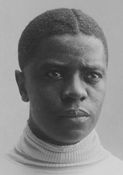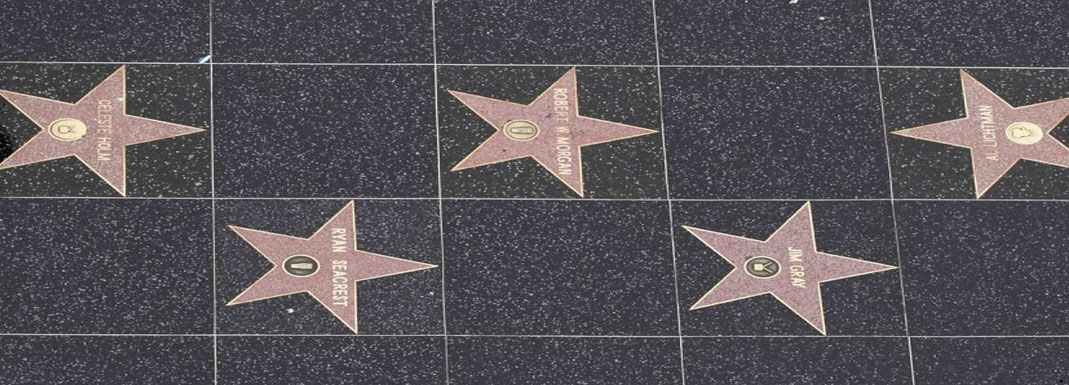 At the turn of the 20th century, cyclist Marshall “Major” Taylor became the first African-American sports hero. That was 10 years before Jackie Robinson was even born and 50 years before he broke the color barrier in major-league baseball. Jack Johnson didn’t win the world heavyweight boxing crown until 1908 and Jesse Owens’s heroic Olympic feats didn’t occur until 1936. Jack Johnson was originally a bicycle racer, but he was injured severely in a horrible wreck in a track race in Texas, so he decided to participate in a less dangerous sport, boxing.
At the turn of the 20th century, cyclist Marshall “Major” Taylor became the first African-American sports hero. That was 10 years before Jackie Robinson was even born and 50 years before he broke the color barrier in major-league baseball. Jack Johnson didn’t win the world heavyweight boxing crown until 1908 and Jesse Owens’s heroic Olympic feats didn’t occur until 1936. Jack Johnson was originally a bicycle racer, but he was injured severely in a horrible wreck in a track race in Texas, so he decided to participate in a less dangerous sport, boxing.
In 1899, at age 21, Major Taylor won the sprint events in world track bicycle championships to become the first African-American to win a world championship in any sport. He went on to break 32 world records at various distances, to become one of the best sprint bicycle racers in the world. Major Taylor was a world champion and world-record holder when bicycle racing was the premier sport in America, far more popular than baseball or football. In the 1890s, Americans had more than five million bicycles and fewer than 300 cars, and they were tired of their horse-manure-covered streets as they moved from traveling by horse and buggy to bicycles and ultimately to automobiles. The Civil War had ended only 30 years before, racial prejudice was smoldering, and the Ku Klux Clan was expanding.
Early Life and Cycling Career
Marshall Walter Taylor was the grandson of slaves and the son of a Civil War veteran who was brought up in the prejudiced south, fought for the North during the Civil War, and was at the fall of Richmond that ended that horrible war. After the war, his parents left “deep-south” Louisville, Kentucky, to live on a farm near Indianapolis, Indiana, where he was born in 1878. When Taylor was nine years old, his father took a job as a horse-and-buggy driver for the wealthy white Southard family. Taylor became a close friend of the Southard’s same-age son and was invited to move in to live with the Southards and receive the same schooling and recreational activities, which included riding a bicycle. However, when Taylor was 12, the Southards moved to Chicago and his mother would not let him go along, so he had to return to the deprivation that was typical for many black children of that era. Fortunately for Taylor, he was allowed to keep the bicycle. He rode it regularly and his incredible athleticism allowed him to perfect all sorts of tricks on the bike. A local bicycle shop owner hired him for $6 a week to attract customers by performing his bicycle stunts in front of the store, and to clean up the shop afterwards. He was called “Major” because he performed his stunts in a military uniform. He then progressed to his next job of teaching people how to ride a bike.
At age 17, his life changed again when he met “Birdie” Munger, a former bicycle racer who taught Taylor how to train to become a bicycle racer, and Taylor won the first race he entered. From his first efforts to enter bicycle races at age 15, he had learned about racial prejudice and was banned from some races. Munger took him along when he moved his bicycle manufacturing shop from Indianapolis to Worcester, Massachusetts, a hotbed for bicycle racing. Taylor worked for Munger as a bicycle mechanic and messenger and became a professional bicycle racer when he was 18 years old. By age 20 he won his first national championship and he set seven world records at various sprint distances. And at age 21 he won his first world sprint championship in Montreal, Canada and was also the national sprint champion in 1899 and 1900. He raced all over the United States and Europe and beat many of the world‘s best racers.
Track bicycle racing is a very dangerous sport. Riders race very fast on a narrow track in a tight pack and often are pushed and shoved right off the track, to the delight of some spectators. In his autobiography, Taylor wrote that 11 of his fellow racers died during races. After he won some races in America, the band played Dixie, but when he won his world championship in Montreal, Canada, the band played The Star-Spangled Banner. He decided to spend many years racing in Europe where his skin color was not an issue.
At age 27 he retired temporarily for two years, but returned to winning races and setting world records until he retired permanently from racing at age 32. His net worth upon retirement was $75,000, equal to $2.5 million today.
Life After Retirement from Cycling
He retired in 1910 and bought a house in Worcester’s expensive Columbus Park, but some of his neighbors didn’t want a black neighbor, so they offered him $2,000 more than he paid to move out. He stayed anyway. In 1925, the Ku Klux Klan had its largest rally in the history of New England near Taylor’s house.
In 1928, twenty years after he retired, he self-published his autobiography, The Fastest Bicycle Rider in the World. He wrote about being a black athlete in a white man’s world:
• Some local race directors refused to let him even enter races,
• restaurants refused to feed him,
• hotels refused to let him spend a night,
• during races, some competitors punched him and tried to push him off of his bike.
He had cold water thrown on him and nails thrown on the road ahead of him. Once after winning a race, he was tackled and knocked unconscious. He wrote that he was abused so often that his coach, Birdie Munger, decided to try to change his skin color. He applied a bleaching cream to Major Taylor’s skin, but instead of whitening his skin, it turned red, blistered, peeled and caused incredible pain. It took several months to heal and even left some scars. After that experience, Taylor said that he would never again try to pass off as a white person and he used his skin color as a motivation to become the best bicycle racer in the world
A Sad Ending
Taylor invested his money in several businesses that failed. By 1930, at age 52, he was in big trouble financially, the stock market crashed, he had lived beyond his means, and he had tremendous medical bills. He was forced to sell his beautiful home in Worcester, his wife and daughter had left him, and he was a very sick man. We know that he had a weakened immune system because he suffered from recurrent painful skin blisters called shingles, chronic blisters caused by the chicken pox virus. He had no money and his only income came from sales of his autobiography. A former bicycle racing buddy offered to pay for a room, so he moved to Chicago and lived in a YMCA Hotel. At age 53, he suffered a heart attack, had some type of heart surgery, and died in the charity ward of Cook County Hospital on June 21, 1932. He was buried in an unmarked pauper’s grave at Mount Glenwood Cemetery. An article on Major Taylor in Wikipedia states that, “In 1948, a group of former professional bicycle racers used funds donated by Frank W. Schwinn, owner of the Schwinn Bicycle Company at that time, to organize the exhumation and reburial of Taylor’s remains in a more prominent location at the cemetery. The plaque at the grave reads: ‘World’s champion bicycle racer who came up the hard way without hatred in his heart, an honest, courageous and God-fearing, clean-living gentlemanly athlete. A credit to his race who always gave out his best. Gone but not forgotten.'”
Cause of Death
Taylor’s death certificate stated that he died of a heart attack caused by high blood pressure from kidney damage called hypertensive nephrosclerosis. Even today, doctors don’t know what causes nephrosclerosis, but they do know that damaged kidneys release hormones that constrict blood vessels to cause severe high blood pressure which is a major risk factor for a heart attack. Risk factors for nephrosclerosis include diabetes, obesity, smoking, and taking certain drugs. I do not know which if any of these factors applied to Taylor. I have no evidence that he took drugs during his professional cycling career, but we do know that bicycle racing is a grueling and exhausting sport and that drugs were rampant in bicycle racing then as they are today. At the turn of the century, bicycle racers were taking narcotics to dull pain, nitroglycerin to widen blood vessels and even large doses of alcohol, none of which have subsequently been shown to improve race performance.
The story of Major Taylor’s life and death has an important message: It is hateful, harmful and hurtful to discriminate against people just because they are different from you.
Marshall Walter “Major” Taylor
November 26, 1878 – June 21, 1932


